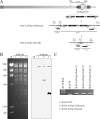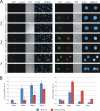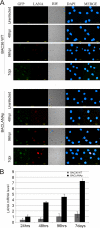The single RBP-Jkappa site within the LANA promoter is crucial for establishing Kaposi's sarcoma-associated herpesvirus latency during primary infection
- PMID: 21507979
- PMCID: PMC3126528
- DOI: 10.1128/JVI.02608-10
The single RBP-Jkappa site within the LANA promoter is crucial for establishing Kaposi's sarcoma-associated herpesvirus latency during primary infection
Abstract
Kaposi's sarcoma-associated herpesvirus (KSHV; or human herpesvirus 8 [HHV8]) is implicated in the pathogenesis of many human malignancies including Kaposi's sarcoma (KS), multicentric Castleman's disease (MCD), and primary effusion lymphoma (PEL). KSHV infection displays two alternative life cycles, referred to as the latent and lytic or productive cycle. Previously, we have reported that the replication and transcription activator (RTA), a major lytic cycle transactivator, contributes to the development of KSHV latency by inducing latency-associated nuclear antigen (LANA) expression during early stages of infection by targeting RBP-Jκ, the master regulator of the Notch signaling pathway. Here, we generated a bacterial artificial chromosome (BAC) KSHV recombinant virus with a deletion of the RBP-Jκ site within the LANA promoter to evaluate the function of the RBP-Jκ cognate site in establishing primary latent infection. The results showed that genetic disruption of the RBP-Jκ binding site within the KSHV LANA promoter led to enhanced expression of the KSHV-encoded immediate early RTA, resulting in an increase in lytic replication during primary infection of human peripheral blood mononuclear cells (PBMCs). This system provides a powerful tool for use in indentifying additional cellular and viral molecules involved in LANA-mediated latency maintenance during the early stages of KSHV infection.
Figures









Similar articles
-
Kaposi's sarcoma-associated herpesvirus reactivation is regulated by interaction of latency-associated nuclear antigen with recombination signal sequence-binding protein Jkappa, the major downstream effector of the Notch signaling pathway.J Virol. 2005 Mar;79(6):3468-78. doi: 10.1128/JVI.79.6.3468-3478.2005. J Virol. 2005. PMID: 15731241 Free PMC article.
-
Induction of Kaposi's sarcoma-associated herpesvirus latency-associated nuclear antigen by the lytic transactivator RTA: a novel mechanism for establishment of latency.J Virol. 2005 Jun;79(12):7453-65. doi: 10.1128/JVI.79.12.7453-7465.2005. J Virol. 2005. PMID: 15919901 Free PMC article.
-
Inhibition of KAP1 enhances hypoxia-induced Kaposi's sarcoma-associated herpesvirus reactivation through RBP-Jκ.J Virol. 2014 Jun;88(12):6873-84. doi: 10.1128/JVI.00283-14. Epub 2014 Apr 2. J Virol. 2014. PMID: 24696491 Free PMC article.
-
Regulation of KSHV Latency and Lytic Reactivation.Viruses. 2020 Sep 17;12(9):1034. doi: 10.3390/v12091034. Viruses. 2020. PMID: 32957532 Free PMC article. Review.
-
KSHV Genome Replication and Maintenance in Latency.Adv Exp Med Biol. 2018;1045:299-320. doi: 10.1007/978-981-10-7230-7_14. Adv Exp Med Biol. 2018. PMID: 29896673 Review.
Cited by
-
Epigenetic regulation of EBV and KSHV latency.Curr Opin Virol. 2013 Jun;3(3):251-9. doi: 10.1016/j.coviro.2013.03.004. Epub 2013 Apr 16. Curr Opin Virol. 2013. PMID: 23601957 Free PMC article. Review.
-
Kaposi's sarcoma-associated herpesvirus genome programming during the early stages of primary infection of peripheral blood mononuclear cells.mBio. 2014 Dec 16;5(6):e02261-14. doi: 10.1128/mBio.02261-14. mBio. 2014. PMID: 25516617 Free PMC article.
-
Cohesins repress Kaposi's sarcoma-associated herpesvirus immediate early gene transcription during latency.J Virol. 2012 Sep;86(17):9454-64. doi: 10.1128/JVI.00787-12. Epub 2012 Jun 27. J Virol. 2012. PMID: 22740398 Free PMC article.
-
KSHV-Mediated Regulation of Par3 and SNAIL Contributes to B-Cell Proliferation.PLoS Pathog. 2016 Jul 27;12(7):e1005801. doi: 10.1371/journal.ppat.1005801. eCollection 2016 Jul. PLoS Pathog. 2016. PMID: 27463802 Free PMC article.
-
H2AX phosphorylation is important for LANA-mediated Kaposi's sarcoma-associated herpesvirus episome persistence.J Virol. 2013 May;87(9):5255-69. doi: 10.1128/JVI.03575-12. Epub 2013 Feb 28. J Virol. 2013. PMID: 23449797 Free PMC article.
References
-
- An F. Q., et al. 2005. The latency-associated nuclear antigen of Kaposi's sarcoma-associated herpesvirus modulates cellular gene expression and protects lymphoid cells from p16 INK4A-induced cell cycle arrest. J. Biol. Chem. 280:3862–3874 - PubMed
-
- Barcy S., et al. 2008. Gamma delta+ T cells involvement in viral immune control of chronic human herpesvirus 8 infection. J. Immunol. 180:3417–3425 - PubMed
-
- Boivin G., Gaudreau A., Routy J. P. 2000. Evaluation of the human herpesvirus 8 DNA load in blood and Kaposi's sarcoma skin lesions from AIDS patients on highly active antiretroviral therapy. AIDS 14:1907–1910 - PubMed
-
- Brown E. E., et al. 2006. Virologic, hematologic, and immunologic risk factors for classic Kaposi sarcoma. Cancer 107:2282–2290 - PubMed
Publication types
MeSH terms
Substances
Grants and funding
LinkOut - more resources
Full Text Sources

